|
How everything started
Many people do not know that American women flew military aircraft
during World War II. However, more than 1,000 female pilots did and their
help was invaluable in releasing many pilots of the Army Air Forces for
combat duty.
Especially, the efforts of two women made this possible: Jacqueline
(Jackie) Cochran and Nancy Harkness Love. The story of how two units of
female pilots, later combined as the Women’s Airforce Service Pilots, were
formed is an amazing part of America’s military history.
.
| When World War II started in September 1939, many people were worried
that soon America could get involved. Jacqueline (“Jackie”) Cochran was
also concerned. In 1939, she wrote Mrs. Franklin D. Roosevelt, the President’s
wife, a letter suggesting that female pilots could provide much help in
war times. By taking over non-combat duties, more male pilots could be
relieved for the active fighting.
Jackie Cochran was a very famous female pilot who had already set
several flying records and won many air races. She knew Mrs. Roosevelt
who personally had presented her the trophy of the International League
of Aviators for being the outstanding women flyer in the world in 1937,
1938 and 1939. Mrs. Roosevelt was a supporter of women’s rights and favored
Jackie Cochran’s idea. Nevertheless, the Army was not interested at that
time. |
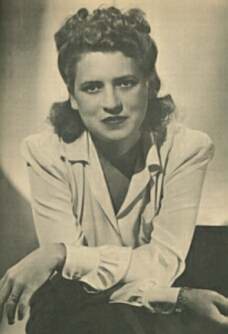 Jacqueline "Jackie" Cochran
Jacqueline "Jackie" Cochran
|
.
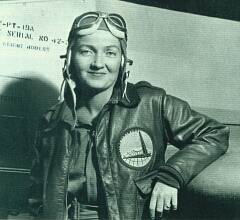 Nancy Harkness Love
Nancy Harkness Love
|
In May 1940, another women pilot, Nancy Harkness Love, made a similar
proposal to the Army’s Air Corps Ferrying Command. She suggested that about
50 very experienced female flyers could ferry planes for the Army from
factories to air bases to relieve male pilots of this duty.
Nancy was not as famous as Jackie was, but she was also a very experienced
and well-known female pilot. She started flying at age 16, practiced several
flying jobs and later started an aircraft sales company in Boston. However,
the Army was uninterested in Nancy’s proposal as well. |
.
| In 1941, Jackie Cochran tried again to convince the Army of her
considerations. At last, her renewed efforts showed first success. General
Arnold, Commanding General of the Army Air Corps, asked Jackie to help
deliver a twin-engine bomber to Britain. Although the United States had
not entered the war yet, the Army supported friendly countries with a lend-lease
program that included delivery of supplies, tanks, aircraft and ammunition.
In June 1941, Jackie Cochran was the first women allowed to fly a military
aircraft across the Atlantic (although she was not allowed to handle the
takeoff and landing). When she arrived in London, she studied a group
of British female pilots who already supported the Royal Air Force by ferrying
planes around the British Isles. |
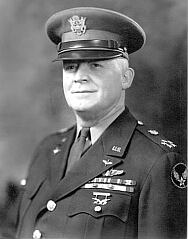 General Harold "Hap" Arnold
General Harold "Hap" Arnold
|
.
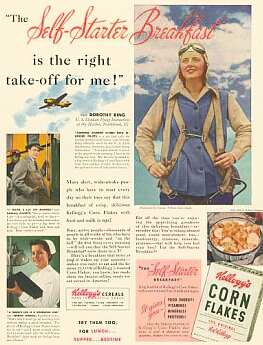
This Kellog's Corn Flakes advertisement
from 1941 shows the US Civilian Flight Instructor Dorothy Ring. Some women
already worked in flying jobs. They impressed the publicity by doing a
job in a working field that was quite new, especially fascinating and men-dominated.
These women, crazy about flying and happy to serve their county,
were the ones Cochran and Nancy wanted to recruit in first line. |
... |
After her return, she spoke at a press conference about
her experiences, and again expressed her ideas to use women pilots to compensate
for the shortage of male pilots in war times. The President and his wife
invited her for lunch to discuss the matter in detail. Shortly after the
dinner, the President permitted Jackie to investigate government records
to determine how many female pilots could be possibly recruited. She found
that nearly 3,000 women had already acquired a pilot’s license.
.
Jackie Cochran set up a plan about how female pilots could support
the Army. Her proposal was to let the more experienced female pilots take
over ferrying missions immediately. Less experienced flyers should get
their extra training in a special flying school. She suggested that the
women’s unit should be led by a woman who would take orders from General
Arnold himself.
.
However, General Arnold turned her plan down again. He explained
there were not enough women with necessary requirements of flight experience
available. Therefore, assuming the problems of housing and training, the
additional efforts could not be justified. If the Army Air Force should
ever start a women’s pilots unit, he promised to put Jackie in charge. |
In the meantime, he recommended that Cochran and other American
female pilots volunteer to go to England and support the British Air Transport
Command. Britain had requested urgently that the United States send pilots
to take over non-combat ferrying missions.
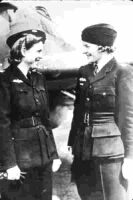 J. Cochran and Pauline Gower, commandant
of the ATA women's section
J. Cochran and Pauline Gower, commandant
of the ATA women's section |
.. |
Jackie Cochran followed his advice. She left for Britain in charge
of a group of 25 American female pilots and joined the British Air Transport
Auxiliary (ATA). Her hope was that she and the other women could prove
their value for the Army Air Forces while serving overseas. Their success
might finally convince the Army to use American women pilots as well. |
|
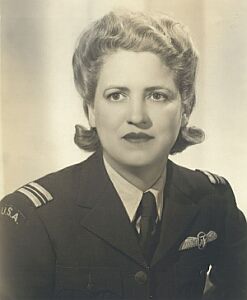 Jackie Cochran in her ATA uniform
Jackie Cochran in her ATA uniform
|
.
| Patch of the Air Corps Ferrying
Command (ACFC). The Ferrying Command was responsibleto fly aircraft
from U.S. factories to Canada and to Atlantic ports for delivery to Great
Britain. Nancy Love's Women's Auxiliary Ferrying Squadron (WAFS) adopted
the ACFC insignia for their standarized uniforms. |
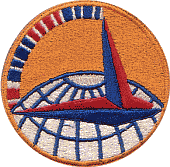
|
| The Ferrying Command was enlarged
into the Air Transport Command (ATC) on 20 June1942. It had world-wide
responsibility for ferrying aircraft, transporting personnel, material,
and mail and also maintained air route facilities outside of the
U.S. |
|
. |
The situation in America changed drastically after the Pearl Harbor
attack in December 1941. The military was not ready to face battles on
several fronts in North Africa, Europe, Asia and the South Pacific. It
did not have enough planes or enough pilots.
With huge efforts, factories produced thousands of new planes in
night and day work. These new planes needed to be delivered to air bases
and the battlefronts. Most pilots were busy flying combat missions and
there were not enough to fulfill both necessary ferrying and fighting.
Major General Robert Olds, leader of the Army Air Corps’ Ferrying
Command, was in desperate need of pilots. He considered hiring civilian
pilots, male and female, for ferrying duties at the beginning of 1942.
When General Arnold was informed about the plans, he immediately forbade
the hiring of female pilots before Jackie Cochran would return from England. |
In May 1942, General Arnold visited Jackie Cochran in England and
consulted her about creating an organization of women pilots in America.
He wanted her to return to the United States to take over the leadership
and start the new women’s unit as soon as possible. Cochran could not leave
immediately because of her obligation to finish ferrying plans in England.
.
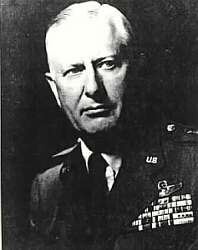
.Colonel
William H. Tunner made his way to a Lieutenant General. He got famous as
the most outstanding authority on airlift operations of the United States
Air Force ( for example the "Hump" operation, the Berlin Airlift and the
Korean Airlift). |
. |
In June 1942, while Jackie was still in England, Colonel William
H. Tunner, commanding officer of the Ferrying Command, met Major Robert
Love who was Nancy Love’s husband. Major Love told Colonel Tunner about
his pilot wife and her ideas. Soon a meeting was arranged. Nancy suggested
creating a small squad of female pilots to take over ferrying missions
to Army air bases.
Tunner informed Brigadier General Harold L. George, successor of
the retired General Olds in the Ferrying Command. Brigadier General George
(who did not know anything about General Arnold’s halt against starting
a women’s pilot unit) agreed with her plans.
Nancy explained she could enroll about 25 women immediately who
would have enough experience for the job. The women pilots should be hired
as civilian ferry pilots for service with the Ferrying Division. To diminish
reservations against female pilots, the women should be restricted to fly
the smallest military planes only, should have two and a half times as
many hours of flying as men (500 hours instead of 200 hours) and should
receive lower pay. |
.
Director Oveta Culp Hobby of the Women’s Army Auxiliary Corps (WAAC)
was informed about the new planned women’s pilots unit. She was asked if
it would be possible to incorporate it into the WAAC, but Director Hobby
had to deny.
The service as pilot, and the additional flight pay pilots needed
to receive, could not be covered by the WAAC regulations without legal
changes. Therefore, an intregation would have been very difficult. Especially,
if one kept in mind that the WAAC law already had several problems to pass
the Congress. Many members of the Congress had prejudices against women
serving with the Army, even as auxiliaries. |
. |
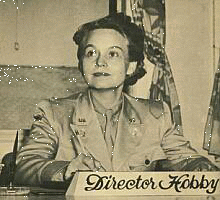
WAAC director Oveta Culp Hobby
The Women's Army Auxiliary Corps was
established in May 1942. Unlike the Women's pilots the WAAC received military
status during 1943. |
.
| Over the next few months, Nancy’s plan was worked out in detail
and statistics of the availability of women pilots were compiled. On September
3, General George gave Love’s proposal to General Arnold and stated he
could implement it within 24 hours. Two days later General George mistakenly
thought he got Arnold’s approval. He initiated formation of the new women’s
unit named Women’s Auxiliary Ferrying Squadron of
women pilots (WAFS) that should function under the Ferrying Division
of the Army Air Forces Air Transport Command (ATC). Nancy Love was appointed
as director of the WAFS. She immediately sent out the first telegrams to
recruit women as civilian pilots for her ferrying squadron. A few days
later, the newspapers were informed about the formation of the new women’s
pilot unit. Because General Arnold was not in his office, Secretary of
War Stimson approved the official announcement. |
. |
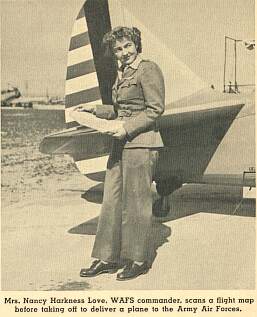 |
.
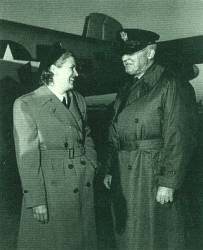 Jackie Cochran and General
"Hap" Arnold
Jackie Cochran and General
"Hap" Arnold
|
... |
Jackie Cochran returned from England to read the news about Nancy
Love’s WAFS and was very upset. She called General Arnold and met him two
days later. General Arnold was very annoyed about the announcement that
he did not know about previously. Since it was not possible to reverse
Nancy Love’s project, and turn her down as director without bad publicity,
Cochran suggested immediately beginning her program as well. Her plan was
laid out with much broader scope. She wanted her pilots, less experienced
than the ones that directly could join Love’s WAFS, to be militarily trained
first. Afterwards her pilots might join the WAFS and ferry planes or they
might also be used for other non-combat jobs. Jackie Cochran’s program
was named the Women’s Flying Training Detachment
(WFTD) and ordered to function under the Flying Training Command
of the Army Air Forces. On September 15, 1942, the WFTD was officially
approved. A day later, Jackie Cochran was appointed as director. |
.
continue to:
.
How everything started
(coming soon)
The Women’s Auxiliary Ferrying Squadron (WAFS)
The Women’s Flying Training Detachment (WFTD)
Foundation of the WASP
The End of the WASP
Late Rewards
.
|
.
[ I. Development ] [
II. Facts about the WASP ] [ III. Uniforms
] [ IV. Sources ]
|
